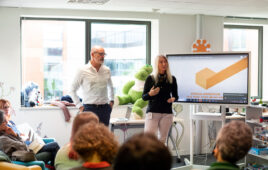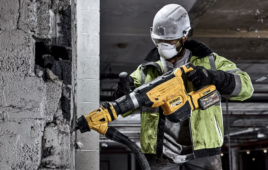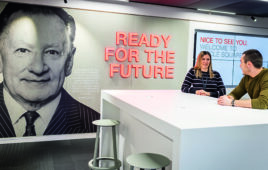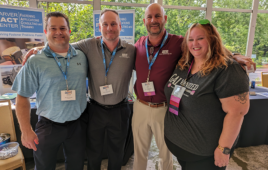
Dieter Ramsauer, the founder of DIRAK.
Ask 80-year-old Dieter Ramsauer about his childhood and he’s likely to tell you about the bicycle he assembled when he was six years old from scrap parts he found around his neighborhood. In fact, he loved building things out of nothing — and still does. After the second world war, there were many piles of discarded objects in his hometown of Velbert, Germany, which he loved to assemble, disassemble, and re-assemble into something new.
It’s perhaps no surprise that years later he founded “Dieter Ramsauer Konstruktionselemente GmbH” in 1991. Konstruktionselemente roughly translates to “construction elements.” The German-based company, now simply known as DIRAK, supplies innovative fitting components for industrial enclosures. What began in a basic office building with just a few employees has grown into a global supplier to dozens of distributors, with multiple locations worldwide (including in the U.S., China, Singapore, India, the Middle East, and others).
“Dieter is a fascinating person,” shares Gregory Breads, CEO of DIRAK. “He’s a toolmaker by trade and initially went through an apprenticeship, which is quite common in Germany, where he still lives today. There, he learned all about design and manufacturing but it’s really an innate talent for him. He’s a tinkerer of sorts who enjoys experimenting with different ideas and creating new things.”
Case-in-point: He built half-a-dozen harpsichords — just for fun. “Apparently, these are concert-level instruments, too,” says Breads. “Dieter is the quintessential engineer-type of designer, who actually puts his ideas into action.” He also designed a line of golf clubs just because he saw room for improvements.
Early in his career, Dieter worked as a sales engineer, which helped him gain perspective on the sheet metal industry and better understand what customers wanted. This resulted in a modular quarter-turn and a rod latch system, which he designed and patented in the late 60s. A quarter-turn serves as a simple and cost-effective way to keep lids, cabinets, or small doors closed. A rod latch is a connection system used for multi-point latching requirements on larger doors.
Later, Dieter would improve on the rod latch so that it could be mounted outside of a seal in the bending area of a switch cabinet to allow for greater open cabinet space.
“Essentially, Dieter would spend his days in sales and evenings working on new projects. This not only led to new designs but also new standards for industrial hardware that he would patent and license to the company,” says Breads.
Many of these patents have since become industry standards. After gaining valuable experience, Dieter eventually ventured out on his own and started DIRAK.
“Our classic quarter-turn is the ideal example of what’s now an industry standard. It’s a very simple concept of a housing, insert, and locking cam. However, Dieter took the basic idea of a lock and standardized the three parts, so that they could easily be swapped out with other versions. This allows a single cutout in the sheet metal to accept a variety of housing styles which, in turn, accepts a variety of inserts and locking cams,” explains Breads.
This means nearly any kind of locking actuation will work with the quarter-turn, whether that’s a screwdriver or a specialized tool.

DIRAK-SNAP-Technology (DST). Click here and here to watch a couple videos on how it works.
“Today, we also have hundreds of patents, thanks to Dieter,” he adds. “Our current claim to fame is something we call DIRAK-SNAP-Technology or DST. In the sheet metal hardware world, generally, attachments are made by either using threaded inserts such as nuts and bolts or by welding. There are pros and cons to each technique, depending on the application. But Dieter had the idea of creating an attachment process that requires no tools.”
This is how DST was developed. Products with DST slide directly through a panel cutout and snap into position, ensuring a strong and secure connection — without the help of additional tools.
According to Breads, the swinghandle was the first example of a product that could be installed without a single piece of additional hardware. And yes, Dieter can also be credited for its design. A swinghandle lies flush against a panel or enclosure when latched and then pulls out to an open position.
“Now, we’ve taken the DST concept and applied it across our entire product range. And this innovation is what truly sets us apart in the industry. Sure, we can supply the industry-standard hardware for enclosures, but we’re continually upgrading and inventing new ideas and raising the standards, too.”
In fact, DIRAK has a catalog of more than 5,000 different standard products but its strength is in its design capabilities. The company is also considered an essential supplier and continues to operate during the current COVID-19 pandemic.
“We are fortunate to say none of our employees have been directly impacted by COVID-19 so far and our operations are still running at 100% capacity, with some staff working remotely if possible,” says Breads. “And we will continue to do so unless operations become a hazard to the safety of our employees.”
Amongst the many industries that DIRAK serves, it supplies to several essential sectors, including telecommunications, power infrastructure, water utilities, and the medical sector.
“We offer a hygiene line of products, for example, that includes extremely high-grade, heavily polished stainless steel, combined with silicone seals that are specifically designed for very sterile environments,” he says. These products can be used in medical equipment, at research facilities, and in the food and drug market.
“We also carry captive fasteners, which I think are quite brilliant,” he says. Captive fasteners provide a permanent hold within a housing or assembly, preventing loss or damage to its fastening components because of a loose or broken part.
“Basically, traditional captive screws are secured to one panel and can then be screwed to a second one,” explains Breads. “So, this means that even if unscrewed from that second panel, the captive screws cannot be removed from the first panel.”
This is important in any enclosure that has a motor or moving parts inside, where it’s critical that the parts don’t fall out or, for safety reasons, that someone can’t reach into the equipment and injure their hand.
“Due to their design, captive screws require very specialized equipment to secure them to the first panel. However, our captive fasteners use DST and do not require any tools at all,” he says. Captive fasteners are often used in medical devices or machine enclosures.
“Peace of mind is so important to us at DIRAK,” he adds. “In fact, it’s so important that it’s become a part of our mission statement as we go through a bit of rebranding in the U.S.” Breads says DIRAK has a set of global values but, as CEO, he wanted to redefine the North American branch to include its own value system.
“We wanted to build the culture of the company from the inside, and not just from the outside,” he says. Last year, Breads sent out a survey to his team and received a similar response from nearly every department.

Karl-Heinz Overhamm, Global Managing Director (left) and Gregory Breads, CEO of DIRAK, Inc. (right).
“About 80% of the respondents said providing peace of mind is something we do best at DIRAK,” he says. “So, for instance, our Sales staff said we take the burden of hardware design off of our customers to provide peace of mind. While Customer Service mentioned that we’re continually working to not only meet but improve delivery deadlines to provide peace of mind. Others noted that we offer free health insurance premiums to our employees, providing peace of mind to them as well.”
He adds: “These peace of mind comments really stood out to me, so that’s become our new purpose statement and I’m quite proud of it.” The company recently put together a video on its new mission statement (which you can view here).
What’s clear is just how strong and supportive of a team Dieter has built at DIRAK.
“Through German engineering and quality to customer service, we take a personal approach with our customers. It’s so important to show we care,” says Breads. “Even Dieter continues to work at our headquarters office nearly every day…or, if he’s not there, chances are he’s busy visiting a customer. He’s quite an inspiration.”






Tell Us What You Think!